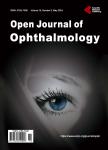Study of the Types of Refractive Disturbances Obseved during Hyperglycemia in Humans
Study of the Types of Refractive Disturbances Obseved during Hyperglycemia in Humans作者机构:Department of Surgery and Specialties University of Health Sciences Libreville Gabon Ophthalmology Unit The Mother-Child University Hospital of Libreville Gabon Department of Physiology University of Health Sciences Libreville Gabon Department of Endocrinology and Metabolic Diseases Libreville Gabon Department of Biochemistry University of Health Sciences Libreville Gabon
出 版 物:《Open Journal of Ophthalmology》 (眼科学期刊(英文))
年 卷 期:2022年第12卷第2期
页 面:142-151页
主 题:Hyperglycemia Hypermetropia Myopia Hypoglycemic Treatment Libreville
摘 要:Introduction: Refractive disturbances have been observed during hyperglycemia. However, there remains controversy as to the types of disturbances that it induces. Objective: To determine the types of refractive disturbances observed during hyperglycemia in humans. Population and Methods: This was an observational and cross-sectional study with an analytical purpose conducted from July to November 2021. Emmetropia, hypermetropia, and myopia as well as blood glucose levels were compared between day 0 (D0) and day 30 (D30) after initiation of hypoglycemic therapy in 222 people (444 eyes) with recently discovered hyperglycemia (Chi-2;p Results: At D0, the mean of blood glucose was 18.1 mmol/L ± 8.2 vs 6.9 mmol/L ± 3.0 at D30 (p = 0.001). At day 0, 80% (n = 355) of eyes were hypermetropic compared to 73.9% (n = 328) at D30 (p = 0.02). At D0, 14.2% of eyes (n = 63) were myopic compared to 11.3% (n = 50) at D30 (p = 0.02). Refraction improved from 0.75 to 1.5D for 34.5% (n = 18) of hypermetropic eyes and 10.2% (n = 2) of myopic eyes. Conclusion: Our results show that hypermetropia is the most common ametropia during hyperglycemia. Moreover, these data suggest that the normalization of blood glucose improves refraction.



